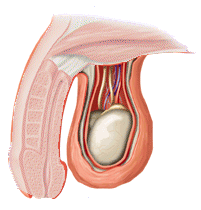The male genital tract consists of the testes, epididymis, vas deferens, prostate, seminal vesicles, and penis. The testes and epididymis, together called the testicles, lie outside the body, contained in the scrotum. The testes has three main types of cell: germ cells which produce sperm, cells called Sertoli cells which nourish the sperm and regulate the effects of hormones produced by the pituitary (see brain mood affecting disorders in the head section), and Leydig cells which make the male hormone testosterone. After puberty the germ cells begin to divide and, by a process called spermatogenesis, produce mature spermatozoa, usually simply called sperm - which takes about 70 to 80 days, and occurs throughout the testis in structures called seminiferous tubules. These tubules drain into the epididymis, which is a highly coiled tube about 6 to 7 metres long lying behind the testis. This is connected to the vas deferens, a muscular tube which is the pathway to the prostate, where it opens together with the duct from the seminal vesicle as the ejaculatory duct. During orgasm the muscular walls of the vas deferens contract vigorously, expelling sperm into the prostatic urethra and thence to the penis. During ejaculation between two and six millilitres of ejaculate will be produced, with each millilitre containing between 20 and 200 million sperms. Sperm production continues throughout the whole of reproductive life, so men may remain fertile until old age. The seminal vesicles lie behind the prostate, one either side, and produce most of the fluid that makes up the ejaculate (which is why men who have had a vasectomy, where the vas deferens is divided and the ejaculate contains no sperm, notice little difference in the volume of semen they produce). | |||
 | This information is licensed for use by Wellbeing Information Systems Ltd ("WIS"), and protected by international copyright law. All rights are reserved. (email info@wisinfo.co.uk). |
